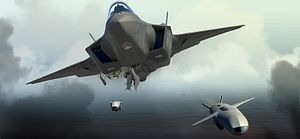Norwegian defense contractor Kongsberg Defense & Aerospace has signed a contract with the Japanese government to provide “the initial deliveries” of next-generation, long-range, precision-guided Joint Strike Missiles (JSMs) for the Japan Air Self-Defense Force’s (JASDF’s) fleet of Lockheed Martin F-35 Lightning II Joint Strike Fighters, the company announced in a March 11 statement.
Kongsberg neither revealed the contract value nor the number of weapons systems to be delivered. The company also did not disclose the timing of the deliveries. The 2019 Japanese defense budget allocated around $71 million to procure an undisclosed number of JSMs.
Japan officially announced in 2017 that it would procure the JSM.“We are planning to introduce the JSM (Joint Strike Missile) that will be mounted on the F-35A (stealth fighter) as ‘stand-off’ missiles that can be fired beyond the range of enemy threats,” then Defense Minister Itsunori Onodera said in December in 2017.
“The international F-35 user consortium is showing great interest in the JSM and Kongsberg is very proud to have been selected by Japan to provide the JSM for their F-35 fleet. This is a major milestone for the JSM program, entering into the production phase,” Eirik Lie, president of Kongsberg Defense & Aerospace, was quoted in the March 11 company statement as saying.
The JSM, co-developed by U.S. defense contractor Raytheon and Kongsberg, is a fifth-generation long-range sea- and land-target cruise missile specifically designed to fit inside the F-35’s weapons bay. Each F-35 can carry two JSMs internally. It can reportedly also be carried by Kawasaki P-1 maritime patrol aircraft.
The JSM is designed for medium-range anti-ship and land attack missions and can “take on high value, heavily defended targets,” according to Raytheon. “The long standoff range (distance from the aircraft to the target) ensures that the aircraft and pilots remain out of harm’s way.”
Development of the JSM was completed in 2018 after a series of validation test firings. The missile program has now entered the “integration” phase. Initial operational capability is expected in 2021 with full-operational capability to be reached in 2025.
Japan currently operates 12 fifth-generation Lightning II F-35As. In January 2018, the JSDF deployed its first F-35A at Misawa Air Base in the northernmost part of Honshu. The first JSDF F-35 fighter squadron will be stood up this year.
The cabinet of Japanese Prime Minister Shinzo Abe approved in December 2018 an increase of Japan’s existing order of 42 to 147 F-35 aircraft that includes an additional 63 F-35As and 42 F-35Bs, the U.S. Marine Corps’ short take-off and vertical landing (STOVL) variant of the aircraft.
“The current NDPG and the fiscal 2019-2023 midterm defense buildup program outline an initial procurement of 27 F-35As and 18 F-35Bs over the next five years,” I wrote in December 2018. “Total acquisition costs for the additional 63 F-35As and 42 F-35Bs will likely exceed $10 billion.”
Notably, the JS Izumo, the lead ship of the Izumo-class, is expected to be converted into an aircraft carrier capable of launching the F-35B.































